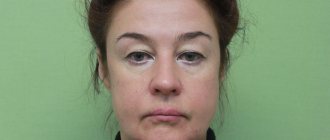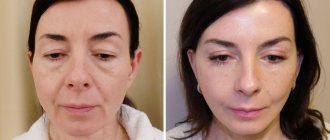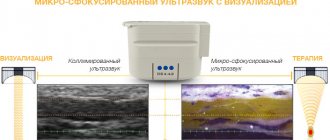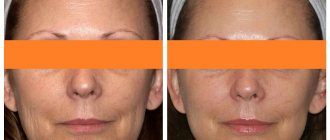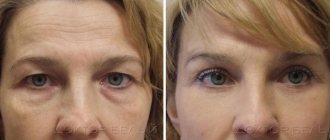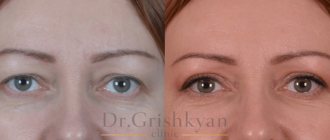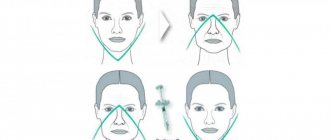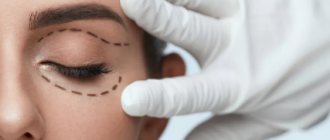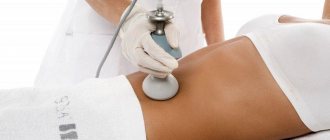Minimally invasive endoscopic technique
The endoscopic equipment used in this operation eliminates the need for large incisions. Our clinic has modern Karl Storz optical video systems with a wide range of tools, thanks to which it is possible to avoid invasive effects on the skin and muscles of the face: multi-layer surgical correction is performed intradermally - through micro-incisions, which avoids the appearance of postoperative scars and scars, and also minimizes the period postoperative rehabilitation of the patient.
Contraindications
Lifting the facial contour and other areas is carried out only after diagnosing the patient’s body. The need for examination arises due to the possible presence of contraindications.
Depending on the plastic surgery method, contraindications may differ, but there is a general list of restrictions under which it is not recommended to correct age-related changes in the face:
- endocrine diseases;
- infectious or acute inflammatory pathologies;
- high blood pressure;
- coagulopathy;
- oncological diseases (malignant/benign type);
- tendency to grow scar tissue;
- a number of dermatological diseases;
- pathologies of the immune system.
The presence of contraindications during a facelift can lead to serious complications.
The essence of the operation
The operation is performed under general anesthesia.
Using the latest endoscopic mini-lifting technique, you can smooth out even large wrinkles and creases in the skin, and correct the contour and oval of the face. Excess subcutaneous fat and tissue are removed through invisible micro-incisions using special surgical instruments. All surgeon manipulations are performed under the control of modern video endoscopic equipment.
Often, when fixing tissues, self-resorbable implant devices are used - endotins, which reliably fix the musculocutaneous frame of the face in a new position until it is completely healed. Thanks to the special structure of the endotin platform and the multi-point effect on the soft tissues of the face, the tension in the corrected area is evenly distributed, which allows you to achieve the most natural effect from this operation.
When performing a mini-lift, some complications that may arise after a conventional lift are excluded, such as changes in the shape of the eyes, inversion of the lower eyelid, and others.
Facial plastic surgery - facelift
Facelift is a plastic surgery that helps eliminate the problem of excess soft tissues of the face, their drooping, correct the nasolabial folds, the oval of the face, i.e., get rid of the signs of gravitational ptosis. This operation is one of the most popular plastic surgeries among patients over the age of 40, as it is aimed at correcting age-related changes in the patient’s appearance. During facelift surgery, severe wrinkles and folds in the face, neck and forehead can be removed, as well as facial volume and contour can be restored, while providing a rejuvenating effect that lasts for many years.
Indications for facelift:
- sagging tissue of the eyelids and outer corners of the eyes
- drooping forehead and eyebrow tissue
- prolapse of the soft tissues of the cheekbones and cheeks
- formation of “jowls”
- forehead and nose wrinkles
- "double chin
- folds and sagging skin in the neck area, etc.
Types of facelift There are several types of facelift . Based on the type of area being treated, the following are distinguished:
- Upper lifting - the method is a lifting of the upper parts of the face - eyebrows and forehead area. As a result, folds and wrinkles are smoothed out, and eyebrow lifting gives the face openness and clarity. This facelift method is used mainly in the presence of deep eyebrow folds and transverse wrinkles, drooping eyebrows and the upper eyelid, which is why the face takes on a gloomy and tired appearance. Incisions are made in the scalp.
- Medium lifting is a tightening of the zygomatic and temporal areas, and the nasolabial folds are reduced. Incisions are made in the temporal region or along the ciliary edge of the lower eyelid.
- Lower lifting – affects the lower jaw area, chin and neck. The incision is made around the auricle.
Depending on the tasks facing the surgeon, either one or several types of lift can be used. For example, a circular facelift , as a rule, involves treating all three zones, but the intensity of the intervention may be different. The volume and tactics of the operation are always determined by the surgeon individually, depending on the characteristics of the patient’s body, his general health, the nature of the problem, individual indications and wishes of the patient.
Based on the depth of intervention, there are:
- Subcutaneous lifting is a tightening of the skin without affecting fatty tissue and facial muscles. The effect of such an operation will be noticeable in patients whose face is still slightly affected by age-related changes, but it is impossible to remove deep gravitational wrinkles using this method. This technique is used extremely rarely.
- SMAS lifti ng - involves working with both the skin and the muscular structure of the face, thanks to which you can achieve significant rejuvenation results.
Classic SMAS lifting
The brief essence of this plastic surgery is that the soft tissues of the face under the skin (this complex of tissues is often called SMAS or the superficial muscular aponeurotic system of the face) are moved in the desired direction, due to which the contours of the face are aligned and sagging is eliminated. After this movement, excess skin is removed. This type of aesthetic surgery has no equal in effectiveness. This type of plastic surgery allows you to voluminously model the face - to highlight or emphasize certain areas of the face, to make certain parts of the face (cheekbones, chin) more expressive. Since it is not the skin that is tightened, but the deep layers of SMAS tissue, it is possible to obtain the desired oval of the face, avoiding changes in the shape of the eyes and mouth, i.e. excessive tension, the so-called “mask effect”.
The incisions are usually located in the scalp and in the natural folds in front and behind the ear. As a result, postoperative scars remain invisible to others.
The technique of such an operation is very complex, since directly under this layer there are branches of the facial nerve, which is responsible for facial movements.
Damage to the facial nerve (due to improperly performed surgery) leads to loss of facial movements of the corresponding half of the face and facial asymmetry. Therefore, only highly qualified surgeons who have undergone special training can perform this type of operation. Short Scar Facelift S-Lift
Many patients seeking facial rejuvenation seek a more limited procedure that does not lead to complications.
The result of this plastic surgery should be a natural appearance and a quick return to normal activities. Today, a facial skin tightening technique known as S-lifting has appeared and proven itself. S – stands for “Short-scar” or “short-flap” lifting or tightening. Indications for surgery
- Mild to moderate ptosis of the lower third of the face and neck
- Formation of age-related jowls
- Pronounced deepening of the nasolabial folds
- Excess fat tissue in the chin area
- Dropping of the contour of soft tissues and skin in the lower jaw area
- Neck laxity
- Ptosis of cheek tissue, partial deformation of adipose tissue
- Weakening of the muscles of the mouth.
The S-lift is suitable for many patients who require a facelift. This procedure allows you to achieve good aesthetic results in all patients with gravitational age-related changes in the lower part of the face, as well as age-related changes in the neck (with the exception of patients with very loose neck skin).
Quite often, S-lifting is performed in conjunction with neck liposuction. The S-lift combines the advantages of a limited skin incision with the advantages of lifting and SMAS manipulation. With its help, you can achieve many things on your “wish list” regarding facial rejuvenation. This technique can improve the natural aesthetics of the face with a minimal skin incision and rehabilitation period. The S-lift is particularly successful in younger patients and patients who require repeated facelift procedures. It is important to note that the S-lift is not just a “mini-lifting” skin incision, but an advanced multifaceted operation to tighten the skin and subcutaneous structures of the face SMAS.
The main feature of the operation is minimal trauma and short scars. Thus, the seam remains invisible to others. At the same time, S-lifting is not a procedure aimed only at tightening the upper layer of skin. The operation affects the deep structures of the face, resulting in global rejuvenation and improved appearance without the effect of a stretched mask.
The incision is made in the parotid area and can be extended to the temporal region.
The short-scar lifting technique allows you to achieve tightening and rejuvenation of the lower third of the face and neck, eliminate age-related jowls, nasolabial folds and ptosis in the lower part of the face. The effect lasts for a long time due to reliable, stable fixation of deep soft tissues. The disadvantages of this technique include rough skin folds that take a long time to straighten or remain forever at the ends of the incisions. Preparation for surgery
Preparation for a facelift, in fact, begins when you first meet a plastic surgeon at a consultation. In an atmosphere of attention, goodwill and confidentiality, your wishes, the realism of your expectations and surgical possibilities for correcting the changes that have occurred are studied. The doctor offers possible alternative facelift techniques. The optimal result of the meeting is the establishment of mutual creative cooperation.
Before surgery, the patient needs to undergo a complete medical examination to identify hidden diseases and possible contraindications to surgery. The surgeon needs comprehensive information about the patient's health status in order to assess possible complications. It is extremely important for the patient to inform the doctor about hidden problems, and in particular those related to blood pressure, blood clotting, or the tendency of tissue to become excessively scarred. You should also inform about the medications you are taking, especially those that affect blood clotting. The surgeon should also be aware of whether the patient smokes or drinks alcohol.
Only after collecting the necessary information about the patient, the specialist begins a detailed examination of his face. During the operation, the anatomical structure of subcutaneous fat and muscles, the facial skeleton and the general condition of the skin are taken into account. Patient preparation begins 14 days before surgery. During this period, quitting smoking and alcohol, taking hormonal medications, and medications that increase bleeding (aspirin, heparin, Trental, etc.) are indicated. The day before, as prescribed by the doctor, tranquilizers are taken - drugs that relieve tension in the nervous system and normalize sleep. Immediately before the operation, the medication is repeated.
The day before the operation, you are allowed to eat only liquid food, and on the day of the operation you must completely stop eating.
On the eve of the operation, the surgeon takes photographs of the patient. Photography is an integral part of preoperative preparation and is very important for assessing the results of the operation. Operation
The operation can be performed either under general or local anesthesia, depending on the type and depth of the intervention.
The patient's position is supine. The operation lasts from 1.5 to 3 hours, and in some cases longer (up to 4-6 hours) - depending on the volume of intervention and the initial data (repeated tightening). Upon completion, regardless of the type of anesthesia, it is recommended to spend at least a day in the hospital. The essence of a facelift is to mobilize and lift tissues that have shifted downward, fix them, remove excess fat (liposuction), skin, straighten wrinkles, folds, and correct stretched muscles. The operation is performed in the supine position, with constant monitoring of the main indicators of the cardiovascular and respiratory systems. The facelift operation ends with drainage of the operating areas, suturing the wounds with cosmetic sutures and applying a special bandage with light compression. After the end of the operation and anesthesia, constant monitoring of all functions of the patient’s body in the ward is carried out. After surgery
As a rule, after a facelift, the patient is observed in the hospital for 2-3 days. Over the next 24 hours after surgery, pain is possible. Immediately after the operation, a tight bandage is applied to the face, which can be replaced with a more “gentle” one the next day. On the first day after the operation, dressing is performed, then the doctor prescribes drug therapy to the patient (individually). Also, the first few days are characterized by swelling of the face, bruises and bruises, which disappear over time. After 4 days, a decrease in swelling is observed (the swelling will completely subside in 2 months), a week after the facelift, the sutures are removed.
However, it will be possible to verify the effectiveness of plastic surgery no earlier than after 2-3 weeks, when swelling and other traces of surgical intervention have decreased.
You can wash your hair and use cosmetics within 3-4 days. For two months after the operation, the patient is advised to refrain from visiting the bathhouse, sauna, hammam, avoid heavy physical activity (do not lift weights exceeding 5 kg), do not dye your hair, and give up smoking and alcohol. Do not sunbathe in the sun or in a solarium for 3 months after surgery.
If you have any questions regarding the operation and the postoperative period, you should contact your surgeon, and not try to find an answer from friends or on the Internet.
To speed up the rehabilitation period, the patient is prescribed microcurrents, lymphatic drainage massage, and a decongestant care complex from a cosmetologist.
You will be able to evaluate the result after the operation and fully enjoy your new “young” face approximately two months after the operation, and its results will last for 8-10 years, if you do not experience serious stress after the operation and do not go on a starvation diet. Cosmetic procedures, contour plastic surgery, laser rejuvenation techniques, and botulinum toxin injections will help consolidate the results.
View price
Preparation and performance of the operation
The method will be effective only in a certain category of patients with characteristic changes in various areas of the face. Indications for a mini-facelift can only be determined after consultation with a plastic surgeon. At this stage, you can also ask the specialist any questions and find out about alternative options for eliminating certain violations.
Preparation for surgery involves a comprehensive examination, which includes:
- Determination of blood group and Rh factor.
- Coagulogram.
- Blood chemistry.
- Analysis of urine.
- ECG.
- Fluorography, etc.
At the stage of planning the operation, it is necessary to stop smoking, drinking alcohol, and in some cases, limit the intake of medications as prescribed by the doctor.
Mini-facelift can be carried out in various ways, one of which is S-lifting. The operation involves making incisions in the area of the anterior edge of the auricle. It is shaped like the letter S, hence the name of the method. This type of mini-facelift allows you to lift the middle and lower areas of the face.
Almost all types of mini-facelift are characterized by a faster rehabilitation period and minimal risk of complications, due to low invasiveness and traumatic nature. However, these features do not exempt the patient from following certain rules during recovery. In addition to various restrictions, in the first few days it is necessary to regularly wear a special elastic bandage, which will help fix the tissue in a new place. The plastic surgeon will tell you the exact recovery plan after the operation.
Indications for short flap facelift
S-face lift is a surgical technique that is indicated for patients with:
- deterioration of the clarity of the oval of the face;
- ptosis of soft tissues in the cheek area;
- sagging skin of the face and neck;
- pronounced, deep nasolabial folds;
- drooping corners of the lips.
Plastic surgery cannot be performed on patients if there are contraindications to surgery. The set of contraindications is divided into medical and aesthetic.
Medical contraindications to a short-flap lift are:
- diabetes;
- cardiovascular pathologies;
- oncological neoplasms;
- blood diseases and autoimmune pathologies;
- hypertonic disease.
If we talk about aesthetic contraindications to surgical facial rejuvenation, then they include:
- pronounced excess skin of the face and neck;
- profound age-related changes in the temporal region, etc.
S-lifting is not performed by a plastic surgeon if during the operation the doctor is unable to achieve the desired cosmetic result. In case of serious age-related changes in the skin of the face and neck, the patient is recommended to undergo a circular lift, during which the doctor works not only with the skin, but also with deep tissues, muscles, and fatty tissue.
results
After the anesthesia wears off, the patient spends at least 24 hours in the clinic under the supervision of doctors. Only after the doctors are convinced that everything is going smoothly, the patient is sent home for further rehabilitation. After the short-scar lift is completed, a compression bandage is applied to the patient’s face, which supports the cheekbone and chin areas. A week after MACS-Lift or S-Lift, swelling and hematomas subside. After 10 days, the stitches are removed. The patient may need to switch to liquid or ground food in order to alleviate painful chewing sensations. The final result of a short-scar facelift can be assessed after 1.5 months.
SMAS lifting is a modern method of correcting age-related changes in the lower and middle part of the face
Modern plastic surgery uses different techniques to correct defects in the lower third of the face, but the SMAS facelift is considered one of the most effective methods. SMAS facelift ( SMAS lifting ) is a plastic surgery aimed at eliminating visual imperfections in the middle and lower parts of the face that have arisen under the influence of natural aging processes.
The patient's satisfaction with the result of the operation directly depends on the extent to which he realizes that all age-related and aesthetic problems cannot be solved during one procedure. The optimal visual effect can be achieved only after performing a forehead lift, lower and upper blepharoplasty, cheek lift, and lipofilling. The need for the above operations is determined in each case individually.
Thus, some patients require only certain correction methods from the list above, while others will have to undergo the entire range of operations aimed at facial rejuvenation.
No matter how much people dream of eternal youth, unfortunately, today we are unable to stop the aging process even if we regularly take high-quality care of our appearance. Negative changes occur under the influence of natural internal processes occurring in our body, as well as a number of external factors: ultraviolet rays, bad habits (smoking and drinking alcoholic beverages), lack of sleep, and regularly experienced stress.
Over the years, a person becomes older. Along with him, his skin also ages: the cell division process slows down, the dermis (lower layers of skin) becomes thinner, and the body’s production of collagen and elastin decreases. As a result, the skin loses its smoothness, elasticity, and moisture, and the degraded protein increases the skin's susceptibility to gravity. Fatty tissue and musculoskeletal structures are also susceptible to aging processes. This causes visible age-related deformation of facial features. The face gradually changes shape and loses clear contours.
Have you decided to do SMAS lifting in Moscow? Where to begin
If you are planning to have a SMAS facelift in Moscow, contact a plastic surgeon who specializes in this area. Choose an experienced doctor who knows modern SMAS lifting methods and is able to perform even much more complex operations than the one you are facing. You can start meeting such specialists with a Ph.D. Ekaterina Sergeevna Kudinova - one of the best plastic surgeons in the capital - an international expert in the field of facial plastic surgery (including SMAS lifting), maxillofacial and reconstructive surgery.
As a leading specialist in the field of facial and nasal plastic surgery, she performs operations of various profiles and levels of complexity. This includes SMAS lifting for patients of a private clinic in Moscow, and particularly difficult operations of post-traumatic facial reconstruction at the Scientific and Clinical Center of Otolaryngology. However, the focus of Dr. Kudinova’s professional interests remains operations on rejuvenation and aesthetic correction of the face, including: SMAS facelift, rhinoplasty, forehead and eyebrow lift, blepharoplasty, chin and neck plastic surgery, transgender plastic surgery.
In addition, Dr. Kudinova performs the following operations: mammoplasty, abdominoplasty, otoplasty, liposuction of the face and body, lipomodeling and others.
Consultations and answers to questions can be obtained by calling +7 (495) 53-23-911 or +7 (903) 790-69-58
Preparation
Carrying out facial contour lifting for the purpose of rejuvenation requires preliminary preparation. If the patient has no obstacles to facial plastic surgery, then at the consultation preceding the operation, the surgeon will tell the patient all the features of the preparatory stage.
In order to prepare for a surgical facelift, it is recommended:
- taking any herbal-based drugs and products that have a blood-thinning effect several days before surgery;
- 4 weeks before surgery stop smoking and drinking alcohol;
- compliance with the rules of proper nutrition;
- 8 hours before the procedure you need to exclude any food and fluid intake;
- on the day of surgery, wash your hair and remove all makeup from your face; do not use facial products.
Depending on the method used to perform a circular or partial facelift in the clinic, there may be separate recommendations.
